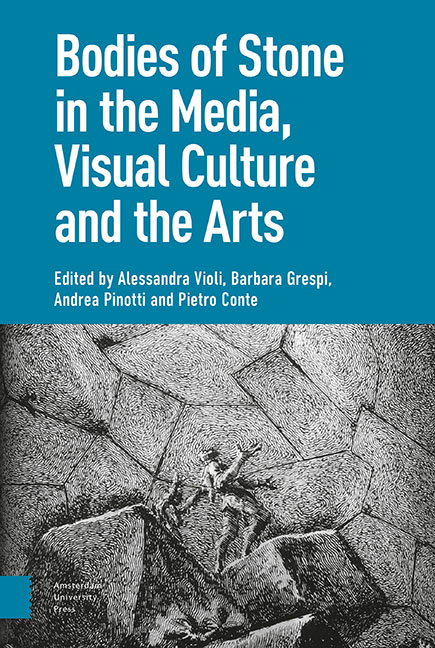Book contents
- Frontmatter
- Contents
- Introduction: Learning from Stone
- I Statue: The Imaginary of Uncertain Petrification
- 1 Theatre and Memory: The Body-as-Statue in Early Modern Culture
- 2 Translated Bodies: A ‘Cartographic’ Approach
- 3 Pantomime in Stone: Performance of the Pose and Animal Camouflage
- 4 Animated Statues and Petrified Bodies: A Journey Inside Fantasy Cinema
- 5 The Ephemeral Cathedral: Bodies of Stone and Configurations of Film
- II Matter: Size, Hardness, Duration
- 1 Bodies That Matter: Miniaturisation and the Origin(s) of ‘Art’
- 2 Brancusi’s ‘Sculpture for the Blind’
- 3 Cinema, Phenomenology and Hyperrealism
- 4 Ephemeral Bodies: The ‘Candles’ of Urs Fischer
- 5 The Celluloid and the Death Mask: Bazin’s and Eisenstein’s Image Anthropology
- III Corpse: Fossils, Auto-Icons, Revenants
- 1 Funeral Eulogy: Post-Mortem Figures and Redeemed Bodies, in Images
- 2 On Jack Torrance As a Fossil Form
- 3 Technical Images and the Transformation of Matter in Eighteenth-Century Tuscany
- 4 Glass, Mixed Media, Stone: The Bodily Stuffs of Suspended Animation
- 5 Bodies’ Strange Stories: Les Revenants and The Leftovers
- IV Monument: Embodying and Grafting
- 1 The Impassibly Fleshly, the Statue of the Impossible
- 2 Frozen into Allegory: Cleopatra’s Cultural Survival
- 3 The Orphan Image
- 4 The Well-Tempered Memorial: Abstraction, Anthropomorphism, Embodiment
- 5 Monuments of the Heart: Living Tombs and Organic Memories in Contemporary Culture
- Index
5 - The Ephemeral Cathedral: Bodies of Stone and Configurations of Film
Published online by Cambridge University Press: 20 November 2020
- Frontmatter
- Contents
- Introduction: Learning from Stone
- I Statue: The Imaginary of Uncertain Petrification
- 1 Theatre and Memory: The Body-as-Statue in Early Modern Culture
- 2 Translated Bodies: A ‘Cartographic’ Approach
- 3 Pantomime in Stone: Performance of the Pose and Animal Camouflage
- 4 Animated Statues and Petrified Bodies: A Journey Inside Fantasy Cinema
- 5 The Ephemeral Cathedral: Bodies of Stone and Configurations of Film
- II Matter: Size, Hardness, Duration
- 1 Bodies That Matter: Miniaturisation and the Origin(s) of ‘Art’
- 2 Brancusi’s ‘Sculpture for the Blind’
- 3 Cinema, Phenomenology and Hyperrealism
- 4 Ephemeral Bodies: The ‘Candles’ of Urs Fischer
- 5 The Celluloid and the Death Mask: Bazin’s and Eisenstein’s Image Anthropology
- III Corpse: Fossils, Auto-Icons, Revenants
- 1 Funeral Eulogy: Post-Mortem Figures and Redeemed Bodies, in Images
- 2 On Jack Torrance As a Fossil Form
- 3 Technical Images and the Transformation of Matter in Eighteenth-Century Tuscany
- 4 Glass, Mixed Media, Stone: The Bodily Stuffs of Suspended Animation
- 5 Bodies’ Strange Stories: Les Revenants and The Leftovers
- IV Monument: Embodying and Grafting
- 1 The Impassibly Fleshly, the Statue of the Impossible
- 2 Frozen into Allegory: Cleopatra’s Cultural Survival
- 3 The Orphan Image
- 4 The Well-Tempered Memorial: Abstraction, Anthropomorphism, Embodiment
- 5 Monuments of the Heart: Living Tombs and Organic Memories in Contemporary Culture
- Index
Summary
Abstract
At first sight, a statue that appears in a film is a prop among others. It can serve to situate the action, it can be an attribute of a character, indicating the person's taste and social status, and it can become a world-making detail, as in historical epics set in antiquity, where statues serve as the kind of ornament used to describe the world of the film and lend it credibility. But as it appears in a film, it raises questions about film as an art of the gesture, and about the power of film to endow inanimate objects with agency.
Keywords: Film theory; film and architecture; gesture; visual culture
La lettre écrite m’a enseigné à écouter la voix humaine, tout comme les grandes attitudes immobiles des statues
m’ont appris à apprécier les gestes.[The written word taught me how to listen to the human voice, just as the great immobile attitudes of the statues taught me how to appreciate gesture.]
‒ Marguerite Yourcenar, Mémoires d’HadrienTwo kinds of props
Statues in film are props, but they are props of a particular kind. Props are inanimate objects that serve to situate the action, explain the character and/ or lend credibility and substance to the world the film evokes. Props are, variously, non-thematic elements of a backdrop, attributes of a character, or the kind of excessive yet indispensable detail that Roland Barthes has in mind when he describes the reality effect of literary realism. As such, props, while inanimate, can take on a life of their own and shift from backdrop to attribute to world-making detail in a matter of seconds. And sometimes, their transformation goes even further. The furniture in Hou Hsiao Hsien's A Time to Live and a Time to Dieis a case in point (Figure 12). Towards the end of the film, the children of An-Hsiao's family discover their father's autobiography among the items bequeathed to them by their late mother. From these few short pages they learn something important about the bamboo furniture in their house, with which the viewer has been made familiar since the first shots of the film.
- Type
- Chapter
- Information
- Bodies of Stone in the Media, Visual Culture and the Arts , pp. 105 - 126Publisher: Amsterdam University PressPrint publication year: 2020

